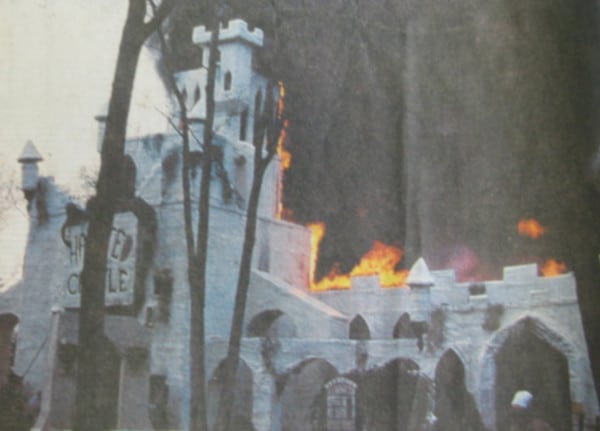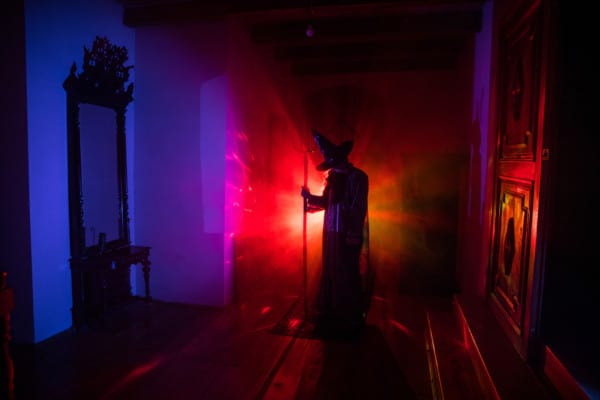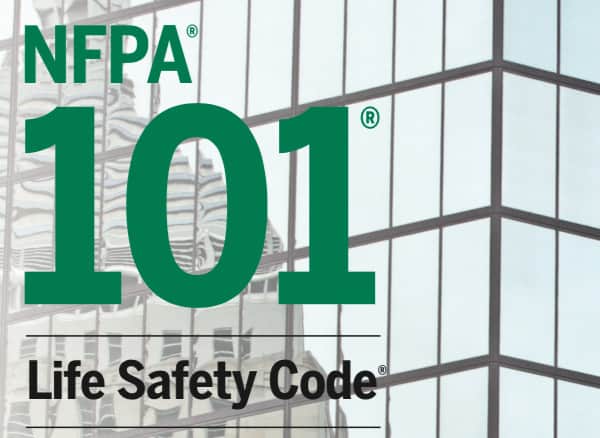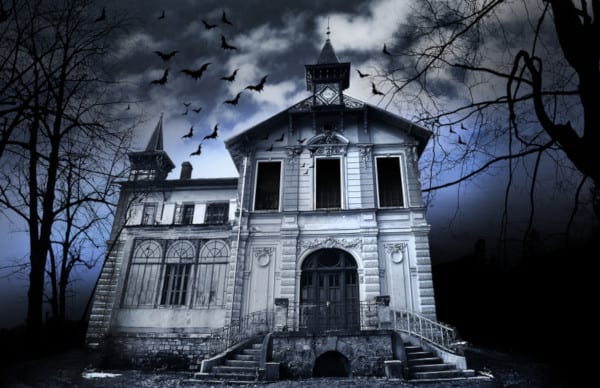Halloween brings haunted houses—and haunted houses come with unique risks that require fire protection measures
In the United States, we usually consider the “holiday season” to be Thanksgiving to New Year’s Day. But an argument could be made that Halloween is the actual kick-off. And some of the biggest draws during the season—haunted houses—can pose serious fire risks if they don’t have appropriate fire protection measures and follow haunted house safety regulations.
This blog reviews the National Fire Protection Association (NFPA) and International Building Code (IBC) requirements for classifying and protecting haunted houses with appropriate fire safety systems.
What makes a haunted house hazardous?
Overall, Halloween presents some seasonal fire risks. NFPA reports that from 2013 to 2017, an average of 780 home structure fires began with decorations every year, and more than 37 percent of those were started by candles. Haunted houses pose their own unique risks, both in the amount of combustible materials and the compromised ability of visitors to escape a fire.
“Haunted houses use special effects, scenery, props, and audio and visual distractions that may cause egress paths to become not obvious,” writes Kristin Bigda, principal fire protection engineer at NFPA. “In haunted houses in particular, the presence of combustible materials and special scenery can also contribute to the fuel load should a fire occur.”
In addition, people usually visit haunted houses at night and are often dressed in costumes and masks that may hinder their movement and vision. Part of the haunted house experience is inching down dark passageways, anticipating a jump-scare around every corner. But the ingredients used to create a creepy atmosphere may also be hiding—or contributing to—hazards unique to these attractions. They require specific classifications, which engender stricter regulations to provide better protection.

The tragedy of the Haunted Castle fire
In 1984, a fire broke out in the Haunted Castle attraction at Six Flags Great Adventure, an amusement park in Jackson Township, New Jersey. Eight teenagers were trapped inside and killed.
The Haunted Castle, a maze of ”commercial truck trailers connected by plywood and wood framing,” was originally intended to be a temporary attraction for the month of October 1979, and only open to patrons at night. It became so popular, however, that it remained in the park for years and was open all day with the rest of the park’s attractions—despite still being considered “temporary.”
The Queens Chronicle reported that prior to the fire, “a safety expert was brought in by the park’s owners to look around [the Haunted Castle] and make recommendations.”
“The first thing on his list was the danger of the Haunted Castle,” according to Peter Smith, who studied the fire and created a documentary about it.
Among the recommendations were installing a sprinkler system, an alarm system, and numerous exit doors. None of these steps were implemented. And after the fire, the park and its parent company were indicted on charges of aggravated manslaughter. A jury found them not guilty, however, and said the blame instead laid with the city of Jackson Township for allowing the park to skirt fire codes. At that point, there weren’t any national model codes that specifically informed state or local haunted house safety regulations.
This video provides a rundown of the history of the attraction, its design, and the fire and its aftermath:
Like many tragedies, the deadly fire at the Haunted Castle spurred changes to haunted house safety regulations that better protect the public today. In 1988, haunted houses were classified as “special amusement buildings” and specific provisions were added to that year’s version of NFPA 101: Life Safety Code. Overall, these include:
- Every special amusement building must be protected throughout by an approved automatic sprinkler system that is properly installed and maintained.
- If the amusement building has low lighting levels, it must be equipped with a smoke detection system, which will sound an alarm at a constantly attended location on the premises.
- In buildings where mazes, mirrors, or other features are used to confound the egress path, approved directional exit marking that will become apparent in an emergency must be installed.
How are haunted houses classified?
Haunted houses are defined as “special amusement buildings” by both the International Building Code and multiple NFPA codes in nearly identical language, notably, NFPA 101: Life Safety Code. They also may be classified as assembly occupancies if they are designed to accommodate 50 or more people.
From the 2018 edition of the IBC
[BG] SPECIAL AMUSEMENT BUILDING. A special amusement building is any temporary or permanent building or portion thereof that is occupied for amusement, entertainment or educational purposes and that contains a device or system that conveys passengers or provides a walkway along, around or over a course in any direction so arranged that the means of egress path is not readily apparent due to visual or audio distractions or is intentionally confounded or is not readily available because of the nature of the attraction or mode of conveyance through the building or structure.
From the 2018 edition of NFPA 101
3.3.37.9 Special Amusement Building. A building that is temporary, permanent, or mobile and contains a device or system that conveys passengers or provides a walkway along, around, or over a course in any direction as a form of amusement arranged so that the egress path is not readily apparent due to visual or audio distractions or an intentionally confounded egress path, or is not readily available due to the mode of conveyance through the building or structure.
In short, exits in these structures are often purposefully hard to find, adding to the thrills and chills. But a hidden or obscured exit and path of egress is obviously dangerous in a fire—and it can easily turn deadly when these buildings also lack adequate fire protection systems and measures.

Haunted house safety regulations: the IBC fire protection rules
The International Building Code places its requirements for special amusement buildings in Chapter 4—“Special Detailed Requirements Based on Use and Occupancy.” Section 411 deals specifically with special amusement buildings. In general, the IBC requires that these structures have:
- A fire alarm system
- A fire sprinkler system
- An emergency voice communication system
- Exit lighting
- Class A interior finishes
Fire alarm system, emergency voice communication system, and exit signs
The fire alarm system is required to be a complete system installed in accordance with the lengthy mandates of NFPA 72: National Fire Alarm and Signaling Code. Upon activation, the alarm system is required to perform multiple simultaneous functions. It shall:
- Sound an audible alarm and send a signal to a constantly attended location where “emergency action can be initiated”
- Activate the emergency voice/alarm communication system
- Activate lighted directional exit markings near the floor
Automatic sprinklers
An automatic fire sprinkler system is also required. However, the IBC does include an exception: If the facility is less than 1,000 square feet and the travel distance to an exit is 50 feet or less, then a fire sprinkler system will not be required.
Class A finishes
All interior finishes, including the wall, ceiling, and floor coverings, are required to have a Class A rating. Class A-rated finishes (as opposed to Class B or C) are the least flammable—they have a flame spread index of 0-25. This index, also known as the “surface burning characteristic rating,” is derived from standard tests that measure “flame growth on the underside of a horizontal test specimen” and assign a relative number from 0 to 100. The lower the number, the less flammable the finish.
All commercial finishes (e.g., from a Home Depot, Lowes, Target, Walmart, etc.), will include documentation on the interior-finish rating of the product. This documentation should be retained in case it is requested by a local code official.
The above requirements apply to all special amusement buildings and additional stipulations may apply based on the occupant load of the structure. If the total occupant load is 50 or more, then the requirements of a Group A occupancy should be applied. If the total occupant load is 50 or more, then the requirements of a Group A-3 occupancy should be applied. If the total occupant load is less than 50, then the requirements of Group B occupancy should be applied. This distinction will primarily affect other fire protection elements, including the amount and type of fire extinguishers, the number of exits and the arrangement required, and the construction materials permitted. Consult your local authority having jurisdiction for the classification and requirements that apply.
Finally, there is one exception that permits the special amusement building to bypass these requirements: if the building has an open-air construction that prevents smoke from gathering within the structure:
From the 2018 edition of IBC
411.1 General.
Exception: Special amusement buildings or portions thereof that are without walls or a roof and constructed to prevent the accumulation of smoke need not comply with this section.

Haunted house safety regulations: the NFPA fire protection rules
The National Fire Protection Association outlines fire protection and life safety requirements for special amusement buildings in NFPA 101: Life Safety Code, as well as NFPA 1: Fire Code. NFPA 101 details these requirements in Chapter 12 (New Assembly Occupancies) and Chapter 13 (Existing Assembly Occupancies). It indicates that a special amusement building must comply with all of the provisions for an assembly occupancy as well as the specific requirements listed in section 12.4.8 unless the structure is “a multilevel play structure” smaller than a certain size:
From the 2018 edition of NFPA 101
12.4.8.1 General. Special amusement buildings, regardless of occupant load, shall meet the requirements for assembly occupancies in addition to the requirements of 12.4.8, unless the special amusement building is a multilevel play structure that is not more than 10 ft. in height and has aggregate horizontal projections not exceeding 160 sq. ft.
The requirements within the IBC and NFPA, for the most part, mirror each other:
- A fire alarm system
- A fire sprinkler system
- An emergency voice communication system
- Exit lighting, a lighted path to the exit, and floor proximity exit signage
- Class A interior finishes
There is a slight difference, however: NFPA 101 lists an exception for installing a fire sprinkler system. A sprinkler system is not required when the structure is less than 10 feet high and does not exceed 160 square feet in “aggregate horizontal projections.”
From the 2018 edition of NFPA 101
A.12.4.8.1 The aggregate horizontal projections of a multilevel play structure are indicative of the number of children who might be within the structure and at risk from a fire or similar emergency. The word “aggregate” is used in recognition of the fact that the platforms and tubes that make up the multilevel play structure run above each other at various levels. In calculating the area of the projections, it is important to account for all areas that might be expected to be occupied within, on top of, or beneath the components of the structure when the structure is used for its intended function.
Do all haunted houses have to follow the rules?
The short answer is “yes,” though different parts of the country have specific haunted house safety regulations and there are additional requirements. And enforcing these laws is one of the reasons why fire marshals are so busy this time of year.
In a recent article published by The Center Square, the Illinois Fire Marshal’s Office explained that “haunted houses can be particularly vulnerable to fire and fire injuries if they do not follow mandated fire safety rules…including regulations on emergency exits and lighting, proper fire extinguishers and proper use of extension cords.” While some religious and nonprofit organizations may submit applications for exemptions to some rules in Illinois, every haunted house in the state must be inspected by state or local fire authorities.
Maryland also strictly follows the state’s adoption of national model code, with state fire marshal Brian S. Geraci issuing a warning to “both owners and attendees to be vigilant when it comes to fire safety requirements at these venues.”
And assistant fire marshal William Jackson in Chattanooga, TN detailed some of the steps taken to ensure haunted house safety: “We’ll do a sprinkler test with an alarm company, a fire alarm test, we’ll also walk through the building to ensure there are clearances between the aisle ways…and clear ways out of the building.”
Watch this video of the process that the Necropolis in Indianapolis, IN follows to get inspected and approved every year:
How can you be sure a haunted house is following safety regulations?
A reputable haunted house attraction will have a permit—and to get permitted, a building must be inspected by safety officials to verify compliance with haunted house safety regulations.
If you have concerns about a haunted house in your area, ask to see the permit or check with the fire marshal’s office in your state. If you are planning on running a haunted house, make sure to choose a site that meets the provisions of all applicable codes and consult with your local authority having jurisdiction (AHJ) for more information on complying with requirements. You can find your state’s fire marshal’s office by visiting firemarshals.org.
Stay safe and have a happy holiday!
To read about some of the deadliest fires in U.S. history that have shaped public safety and fire code, check out previous QRFS blogs covering:
- The Iroquois Theater and Triangle Shirtwaist fires
- The Our Lady of the Angels School and the Station Nightclub fires
- The Las Vegas MGM Grand fire
- The Beverly Hills Supper Club fire
QRFS is dedicated to fire safety. If you need fire extinguishers, fire sprinklers, fire protection test equipment, or anything else needed to protect lives and property, feel free to view our online selection.
If you have questions or need help finding an item, call us at +1 (888) 361-6662 or email support@qrfs.com.
This blog was originally posted at blog.qrfs.com. If this article helped you, check us out at Facebook.com/QuickResponseFireSupply or on Twitter @QuickResponseFS.



